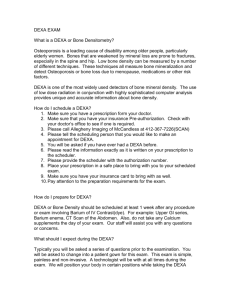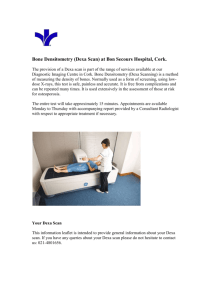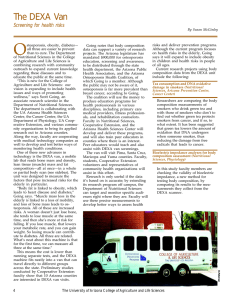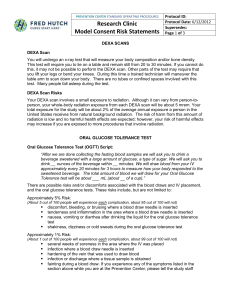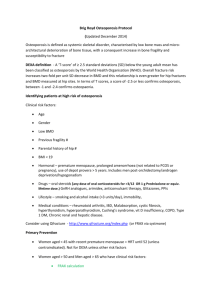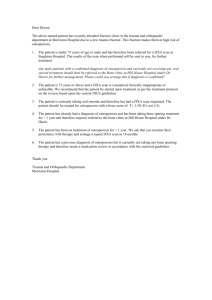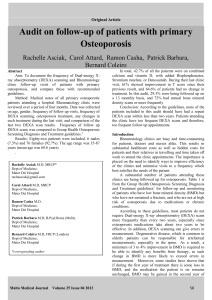DEXAs
advertisement
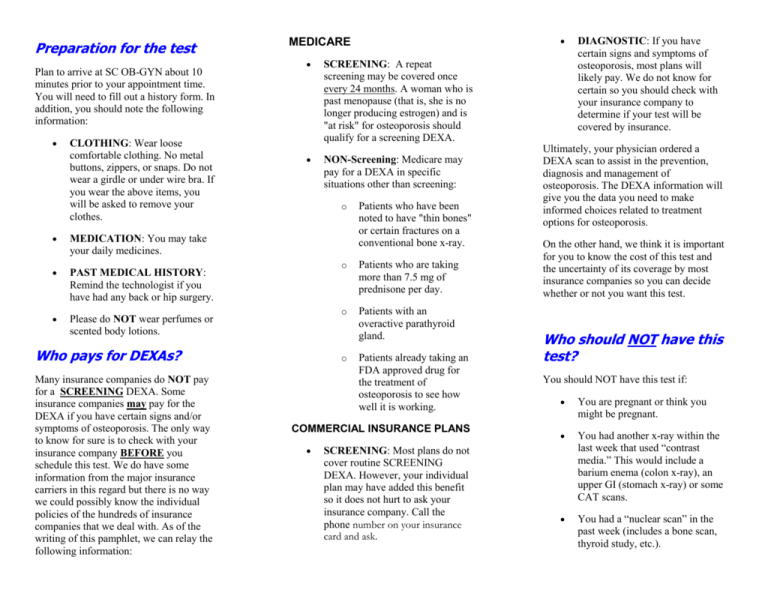
Preparation for the test Plan to arrive at SC OB-GYN about 10 minutes prior to your appointment time. You will need to fill out a history form. In addition, you should note the following information: CLOTHING: Wear loose comfortable clothing. No metal buttons, zippers, or snaps. Do not wear a girdle or under wire bra. If you wear the above items, you will be asked to remove your clothes. MEDICATION: You may take your daily medicines. PAST MEDICAL HISTORY: Remind the technologist if you have had any back or hip surgery. Please do NOT wear perfumes or scented body lotions. SCREENING: A repeat screening may be covered once every 24 months. A woman who is past menopause (that is, she is no longer producing estrogen) and is "at risk" for osteoporosis should qualify for a screening DEXA. NON-Screening: Medicare may pay for a DEXA in specific situations other than screening: o Who pays for DEXAs? Many insurance companies do NOT pay for a SCREENING DEXA. Some insurance companies may pay for the DEXA if you have certain signs and/or symptoms of osteoporosis. The only way to know for sure is to check with your insurance company BEFORE you schedule this test. We do have some information from the major insurance carriers in this regard but there is no way we could possibly know the individual policies of the hundreds of insurance companies that we deal with. As of the writing of this pamphlet, we can relay the following information: MEDICARE Patients who have been noted to have "thin bones" or certain fractures on a conventional bone x-ray. o Patients who are taking more than 7.5 mg of prednisone per day. o Patients with an overactive parathyroid gland. o Patients already taking an FDA approved drug for the treatment of osteoporosis to see how well it is working. COMMERCIAL INSURANCE PLANS SCREENING: Most plans do not cover routine SCREENING DEXA. However, your individual plan may have added this benefit so it does not hurt to ask your insurance company. Call the phone number on your insurance card and ask. DIAGNOSTIC: If you have certain signs and symptoms of osteoporosis, most plans will likely pay. We do not know for certain so you should check with your insurance company to determine if your test will be covered by insurance. Ultimately, your physician ordered a DEXA scan to assist in the prevention, diagnosis and management of osteoporosis. The DEXA information will give you the data you need to make informed choices related to treatment options for osteoporosis. On the other hand, we think it is important for you to know the cost of this test and the uncertainty of its coverage by most insurance companies so you can decide whether or not you want this test. Who should NOT have this test? You should NOT have this test if: You are pregnant or think you might be pregnant. You had another x-ray within the last week that used “contrast media.” This would include a barium enema (colon x-ray), an upper GI (stomach x-ray) or some CAT scans. You had a “nuclear scan” in the past week (includes a bone scan, thyroid study, etc.). DEXA Scan What Are the Results? A Bone Density Test measures your bone health. The result of the test is called a TScore and you should know what it means. According to the World Health Organization, osteoporosis is defined based on the following bone density TScore levels: O to –1.0 = Normal Bone Density -1.0 to –2.5 = Low Bone Mass or Osteopenia -2.5 or lower = Osteoporosis and increased risk of fractures. What is a "DEXA" scan? DEXA is an abbreviation for "Dual Energy X-ray Absorptiometry". This is a special x-ray procedure that determines the strength of your bones. Bone strength is assessed by measuring the bone density so a DEXA scanner is sometimes called a "bone densitometer." Other means of assessing bone strength are also available, but a DEXA scan is currently the most accurate method and it uses the lowest amount of radiation (a standard chest x-ray exposes you to 10 times more radiation than a DEXA scan). The DEXA scanner at SC OB-GYN is a state of the art machine. Our bone densitometry technologist is certified by the International Society of Clinical Densitometry and by SCRQSA. The DEXA SCAN only tells your doctor the density of your bones. The scan DOES NOT show arthritis, fractures, fractured vertebra or fractures of the hip. More Questions…? We hope this information has been helpful. If you have additional questions about the DEXA scanner or osteoporosis, please ask. Again, we suggest you first check with your insurance company if you are concerned whether they will pay for your DEXA scan. How is a DEXA scan done? How to Schedule? Call: Email: scobgyn@hotmail.com www.scobgyn.YourMD.com 803-254-1300 OB-GYN Associates, P.A. South Carolina South Carolina 1333 Taylor Street, Suite 2-D OB~GYN (803) 254-1300 www.scobgyn.YourMD.com (Rev 4/06) Or, ask your doctor for this test the next time you are in the office. Columbia, SC 29201 First…Relax. It is absolutely painless. All you have to do is lie flat on a table while the scanner moves over the top of your body. Generally, the bone density is measured at 2 different sites in the body, usually the hip (or femur) and the spine (or vertebral column). If you have had both hips surgically replaced or if you have had surgery on your spine, an alternative site may be chosen. Also, if your weight exceeds the table limit (265 pounds), a forearm scan may be substituted. You should allot 60 minutes for the entire procedure.
